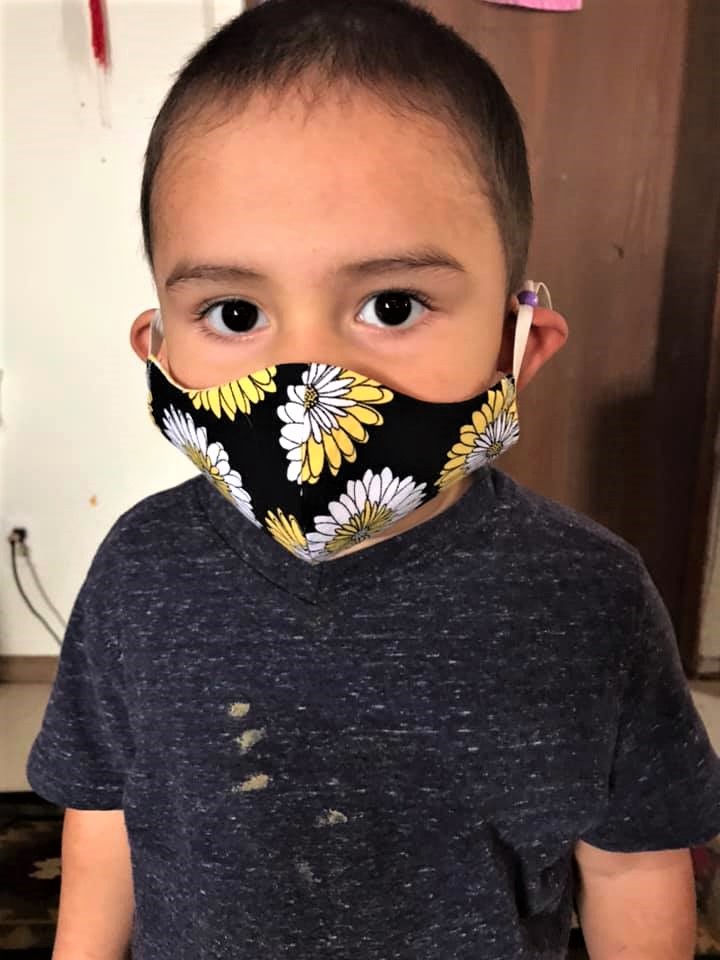Pandemic protocols portend census undercount on tribal lands

Oglala Lakota tike Lucas Weston is following protocol, protecting himself and family from the Covid-19 pandemic, and “loves wearing his mask,” says his mother Dana K. Richards. Credit COURTESY / Dana K. Richards
FLANDREAU – As of June 1, U.S. Census Bureau decennial survey personnel had missed their 2020 field operation targets on all but one of South Dakota’s nine Indian reservations, illustrating the nationwide threat of an alarming Native American population undercount due to coronavirus pandemic safety protocols.
The only tribal jurisdiction in the state where the census team has delivered forms to residents is the Flandreau Santee Sioux Indian Reservation, according to Mike Beck, the U.S. Census Bureau media specialist for South Dakota.
The bureau has permission from the Sisseton Wahpeton Oyate, Oglala Sioux and Rosebud Sioux tribes to send workers onto reservations, but operations have not yet begun, he told the Native Sun News Today.
He also said the Cheyenne River Sioux Tribe will allow operations but has not indicated when, and the Yankton Sioux Tribe has yet to hold a council meeting before deciding.
The census team has not yet heard from the Crow Creek, Lower Brule, or Standing Rock Sioux tribes.
The bureau began field operations in mid-March but stopped after only three days because of its pandemic protocols. While crews resumed this work in early May, they have not been able to deliver census forms on some tribal lands because of reservation coronavirus lockdowns.
“Almost 90 percent of the 6.7 million addresses throughout rural America, in tribal lands particularly, never got invites, never got an opportunity to respond to the census,” said Tim Olson, associate director of Field Operations for the U.S. Census Bureau.
“In Arizona, we’ve opened all areas minus the Navajo Nation…. We’re holding off on that area until tribal leadership says it’s okay to resume work on their tribal lands,” he added.
The “invites” are called Update Leave packets, forms brought directly to peoples’ homes by census workers. Update Leave operations happen on what the Census Bureau considers “hard-to-count tracts”, largely made up of communities that receive their mail in post office boxes instead of at home addresses.
The Census Bureau does not mail forms to post office boxes because they cannot be matched to physical addresses — essential to the count. This means getting an accurate count on many tribal lands relies more heavily on Update Leave.
According to the National Congress for American Indians (NCAI), 52.4 percent of American Indians in South Dakota live in hard-to-count areas. This is the fourth highest rate in the nation after New Mexico, Arizona and Alaska.
When asked during an NCAI webinar discussion on May 26 what the Census Bureau would do if employees don’t get the green light from tribes to come onto reservations before the extended Oct. 31 deadline, Olson said there is no backup plan.
“I’m not sure honestly how to answer that,” he said. “If we can’t do the Update Leave, then we’ve got a different problem that would be larger than the Navajo Nation. We’re going to keep our fingers crossed that we can do these operations safely for our employees and safe for the residents in these timeframes.”
American Indians and Alaska Natives were the most undercounted population group in the 2010 Census at 4.9 percent, more than twice the rate of the next undercounted group. In 1990, the undercount was even more dismal at 12 percent.
The census determines political representation and billions of dollars of funding for tribes for the following 10 years. This is why NCAI and many other indigenous-led organizations and tribal members are concerned about how the pandemic will affect the counting of Native Americans this time around.
“Making sure that Native Americans are accurately counted in Census 2020 is a top civil rights issue in Indian country today,” says the Native American Rights Fund (NARF) website. “Past undercounts of native populations have deprived hundreds of thousands of Native Americans of their voice in government.”
“The Covid-19 pandemic is having an unprecedented impact on efforts to get a complete count in Indian Country,” said NARF Staff Attorney Natalie Landreth. “If Bureau staff and their national and tribal partners do not have sufficient time to complete the count of urban Natives and those living on reservations, entire tribal nations could virtually disappear,” she said.
“That will cost tribes and the state and local communities where they are located billions of dollars in lost federal funding, and deprive [American Indians and Alaska Natives] of their Constitutional right to vote,” she added.
During the webinar, Olson said the Census Bureau has requested Congress extend the current Dec. 31, 2020 deadline for completing population counts to April 30, 2021.
Once people get their Update Leave packet, they can respond either by filling out and mailing in the paper questionnaire or going online and filling out the form using the ID provided in the materials. The response also can be submitted over the phone by calling 1-844-330-2020.
(Contact Justine Anderson at justinekanderson@gmail.com)
